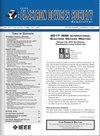Conductivity Enhancement of PVD-WS2 Films Using Cl2-Plasma Treatment Followed by Sulfur-Vapor Annealing
IF 2
3区 工程技术
Q3 ENGINEERING, ELECTRICAL & ELECTRONIC
引用次数: 0
Abstract
The conductivity of tungsten disulfide (WS2) films using sputtering, which is a physical vapor deposition (PVD), was enhanced using a chlorine (Cl2)-plasma treatment and sulfur-vapor annealing (SVA). For WS2 films to be used in thermoelectric devices, its carrier concentration must be controlled. Therefore, we exposed WS2 films to Cl2-plasma as a doping method. In addition, SVA was performed to improve the crystallinity of the film and potentially introduce activating dopants. Consequently, the conductivity of the Cl2-plasma-treated PVD-WS2 films (0.440 S/m) more than doubled compared with that of an untreated PVD-WS2 film (0.201 S/m). The doping type in this experiment is considered to be n-type on the basis of a positive peak shift observed in the X-ray photoelectron spectra.利用 Cl2 等离子处理和硫气退火增强 PVD-WS2 薄膜的导电性
二硫化钨(WS2)薄膜是一种物理气相沉积(PVD)技术,采用溅射法(即物理气相沉积),通过氯(Cl2)等离子体处理和硫气退火(SVA)增强了其导电性。要将 WS2 薄膜用于热电设备,必须控制其载流子浓度。因此,我们将 WS2 薄膜暴露在 Cl2-等离子体中,作为一种掺杂方法。此外,还进行了 SVA 处理,以提高薄膜的结晶度,并可能引入活化掺杂剂。结果,经 Cl2- 等离子体处理的 PVD-WS2 薄膜的电导率(0.440 S/m)比未经处理的 PVD-WS2 薄膜的电导率(0.201 S/m)提高了一倍多。根据 X 射线光电子能谱中观察到的正峰值移动,本实验中的掺杂类型被认为是 n 型。
本文章由计算机程序翻译,如有差异,请以英文原文为准。
求助全文
约1分钟内获得全文
求助全文
来源期刊

IEEE Journal of the Electron Devices Society
Biochemistry, Genetics and Molecular Biology-Biotechnology
CiteScore
5.20
自引率
4.30%
发文量
124
审稿时长
9 weeks
期刊介绍:
The IEEE Journal of the Electron Devices Society (J-EDS) is an open-access, fully electronic scientific journal publishing papers ranging from fundamental to applied research that are scientifically rigorous and relevant to electron devices. The J-EDS publishes original and significant contributions relating to the theory, modelling, design, performance, and reliability of electron and ion integrated circuit devices and interconnects, involving insulators, metals, organic materials, micro-plasmas, semiconductors, quantum-effect structures, vacuum devices, and emerging materials with applications in bioelectronics, biomedical electronics, computation, communications, displays, microelectromechanics, imaging, micro-actuators, nanodevices, optoelectronics, photovoltaics, power IC''s, and micro-sensors. Tutorial and review papers on these subjects are, also, published. And, occasionally special issues with a collection of papers on particular areas in more depth and breadth are, also, published. J-EDS publishes all papers that are judged to be technically valid and original.
 求助内容:
求助内容: 应助结果提醒方式:
应助结果提醒方式:


